If you're planning on creating an audio/video streaming platform, you're likely to be interested in the cost-efficiency of your future project. A good idea is to consider using an API. This approach would allow significantly reducing your development budget. And we guess you don’t mind saving a little bit, right? However, you'll find more details in our article.
You’ll see how APIs work and read our tips on choosing the best solution. Also, we’ll describe what the modern market provides us with by listing 15 Top Streaming APIs so that you know all the options on hand.
How does an API help your streaming platform?
Video live streaming solutions of one sort or another would come in handy for almost any resource, as they are a great way to push up conversions and increase user flow.
There are a host of ideas on how to take advantage of streaming features: the same news channel or live webcast of conferences... Or maybe you provide a platform for other streamers (say, musicians, artists, and so on). Why not? And if we talk about e-commerce, there is also something to think about.
Imagine: you have a shop, and you decided to install a camera to broadcast what is happening there on your site (given you have both a real and an online store). Therefore, you need a certain media server to receive video from your camera and transfer it to the website in the correct format in multithreaded mode, allowing the user of the web resource to monitor the activity of your customers.
And how to organize such a complicated process in the simplest way? This is where you can benefit from live streaming APIs!
API code
API stands for Application Programming Interface and can be described as a set of ready-made classes, functions, procedures, structures, constants, and so on. In fact, we’re talking about an interaction interface between your website and third-party programs and servers. A developer is free to use the API to access the functionality of a third-party service so that it fulfills its task (in your case, the task is to help you supplement your resource with a video/audio streaming feature).
In the wake, the client gets the result he needs without unnecessary costs, and the developer gets the opportunity to significantly facilitate his work. A win-win situation!
To make the picture absolutely clear: imagine dinner in a cafe. You’re a customer choosing a dish on the menu. The chef in the kitchen is the future performer of your order. And you need an intermediary to inform him of your choice and, when the food is ready, bring it to you. It is at this point that the waiter - the API - comes into play.
And this also applies to our case. You need a video streaming solution. And you don’t want to create everything from scratch and perform a complicated (and costly!) server setup (an analogy with the cafe example: you don’t want to cook the dish yourself). Therefore, you should seek help from a third-party service (the chef in the kitchen). And you can do it by choosing a video streaming API (the waiter).
The service receives your online stream, transcodes to many adaptive streams, and delivers to a variety of browsers and devices. Live video streaming APIs help in managing the process.
Of course, in addition to video and music streaming APIs, there are many other options (the same API Facebook that companies use to provide their customers with quick and easy access to their platforms). But all of them are united by the type to which they belong:
-
Public-facing APIs. They are publicly available, although sometimes paid. Providers share a set of input parameters that developers use to achieve some kind of result.
-
Private APIs focused on internal corporate use (say, if a company has many software products and requires a special programming interface to establish effective interaction between them).
Player APIs or Live Streaming API?
Some may find these concepts identical, but there is a difference between them. Let's figure it out!
What is a player API?
The first case is a simple one, directly related to a video player: its visual design and default features. With the appropriate API, the user can manage the settings of the video player, including changing its size, supplementing it with a company logo, adding buttons, and so on.
What is a live video streaming API?
This is a more complicated case. Here we’re talking about managing live video streams themselves: adding, starting, stopping or rename them, changing their description and settings, and so on, which, you see, is a rather difficult task. And various live video streaming APIs are aimed at helping to simplify it.
Ideally, if the vendor offers all the required features, as Dailymotion does, which is discussed below. Companies of this type help in processing streams and returning encoded video to the client. Moreover, they provide both a player and a content delivery system at the same time.
However, we offer a closer look at a few convincing examples of APIs.
List of the Top Audio and Video Streaming APIs
The services we describe offer the client a certain set of features available through a user-friendly interface, enhanced by a powerful API.
Most vendors from the list below, such as Brightcove and Ooyala, are full-fledged video platforms, implying that the content management service is supplemented with streaming functionality. This opens up great opportunities for companies needing both VOD and live streaming solutions.
YouTube
YouTube is on everyone’s lips, and you’ve definitely heard of it too. It is provided by another IT giant, namely Google. Although YouTube Live Streaming API is a fairly simple service, it has a number of benefits, in particular, advanced functionality.
This API opens up programmatic access to the broadcast service and allows performing various kinds of actions on Live Events (their creation, modification, etc.). There is a great opportunity to stream to multiple platforms simultaneously or integrate broadcasting on YouTube through the application.
So, YouTube Live Streaming API is an affordable and easy-to-implement solution. And the result is quite decent!
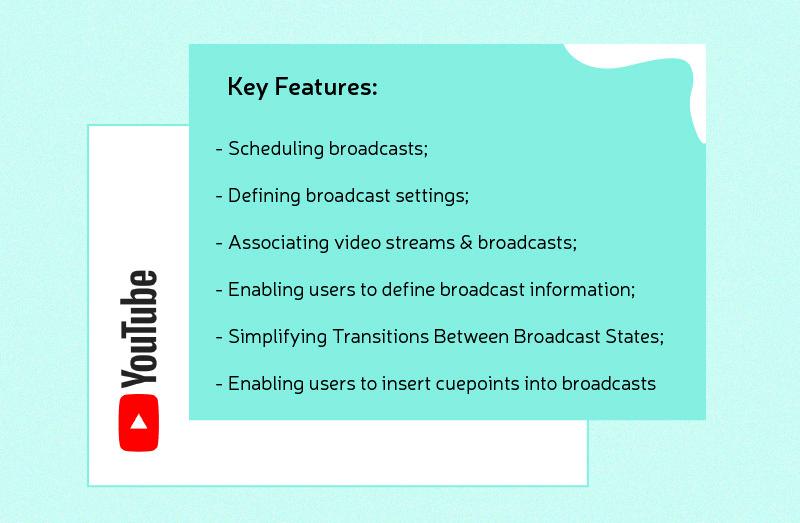
Dailymotion
Dailymotion is a famous French video hosting service, which is one of the most visited sites in the world (114th place in the ranking according to Alexa Internet as of 2017, and this, you see, is a good indicator).
Of course, Dailymotion also provides a programming interface with a great many cool APIs features to help developers in their job. In particular, we'd like to mention Dailymotion Cloud designed for storing videos of other hosting sites and converting them into different formats (those that would work on a particular platform).
In general, the issue of multi-platform is at the forefront. The owners of the service want their Dailymotion API to help clients integrate videos without any hindrance, regardless of the platform they choose (whether it’s Android, iOS, PC, etc.).
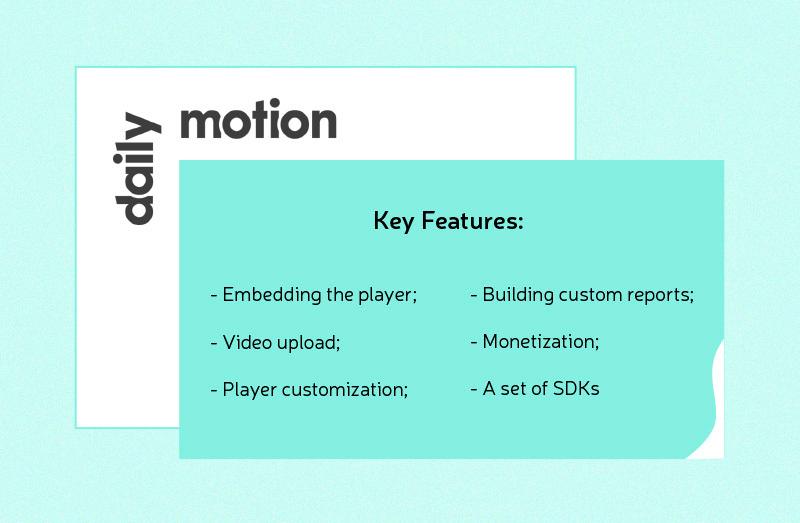
Wurl Video
Another live streaming API worth considering is Wurl. It belongs to the white-label providers, which is a big advantage, and aims to make the development process much easier. Using Wurl API, developers can extract needed metadata and broadcast videos on their platforms under their own brand (or, rather, under their client’s brand).
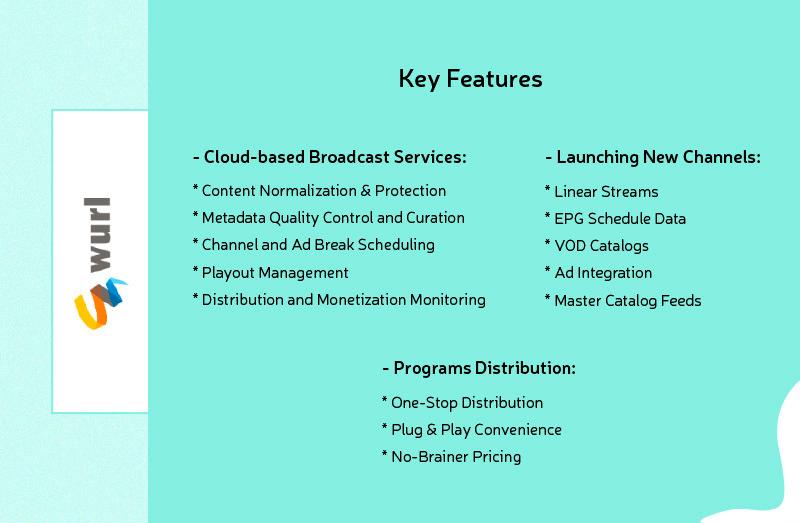
Vimeo
The history of the American video hosting Vimeo began in 2004, and over the past years, the service has achieved considerable success. So, in the spring of 2018, Vimeo ranked 91st among web resources in the United States and 130th on a global scale. In addition to the web platform, Vimeo also supports the mobile OS (both Android and iOS).
Using an API that Vimeo kindly provides us with, developers have a chance to escape a lot of the hardship and ensure the top-notch integration of video with the web and mobile resources. Moreover, Vimeo offers not only streaming and VOD features but also a customizable player, as well as the delivery of manageable content.
As for the vendor's pricing policy, there are various possibilities: from an affordable package of services aimed at one user (without the possibility of live streaming, $ 7 per month), to an expensive premium package with unlimited live streaming ($ 75 per month). In addition, there are several intermediate options (Pro, $ 20 per month, and Business, $ 50 per month).

Brightcove
Brightcove is focused on interacting with large and medium-sized businesses, including media and TV providers (by offering services such as TVE (TV Everywhere) technology and OTT (Over The Top) content support).
Brightcove functionality includes transcoding, integration with various marketing platforms, monetization options, ad blocking, and more.
Still further, Brightcove offers a wide range of well-documented APIs (not only live video streaming APIs). The vendor belongs to full-fledged video platforms, which have it all, as they say. We should add that Brightcove works in the cloud and requires the creation of a Video Cloud account.
Speaking about the cost of services, it’s difficult to determine their price level. You may take advantage of the 30-day trial period, and then decide whether the game is worth the candle. And if the answer is yes, contact the company for further details.
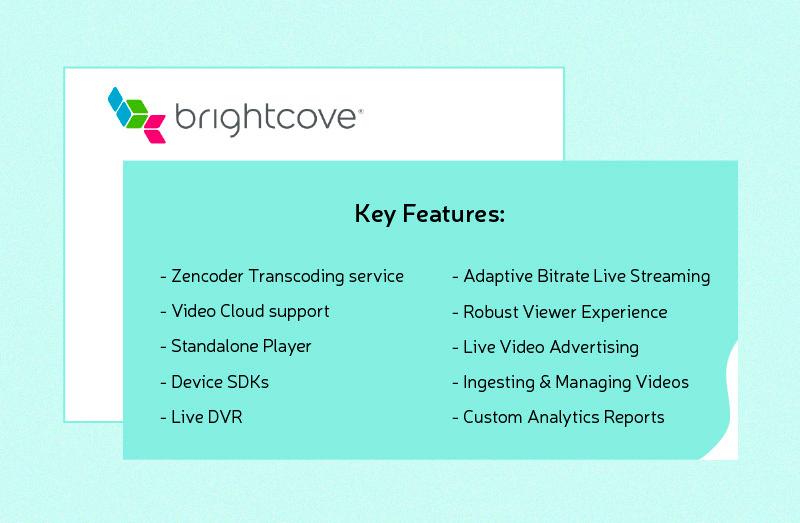
DaCast
DaCast offers online broadcasting and video-on-demand services, and also promises the absence of advertising, the possibility of monetization and branding, as well as ongoing technical support.
DaCast has its APIs and SDKs that provide access to various features, including live streaming and VOD with the Akamai CDN (see the whole list of APIs features below). All these SDKs and video streaming APIs are wonderful tools helping you integrate your products with the platform or create your own apps, without any hassle.
Additional benefits:
-
reliable security settings allowing users to restrict access to content;
-
flexible and affordable pricing (and all packages offer decent conditions).
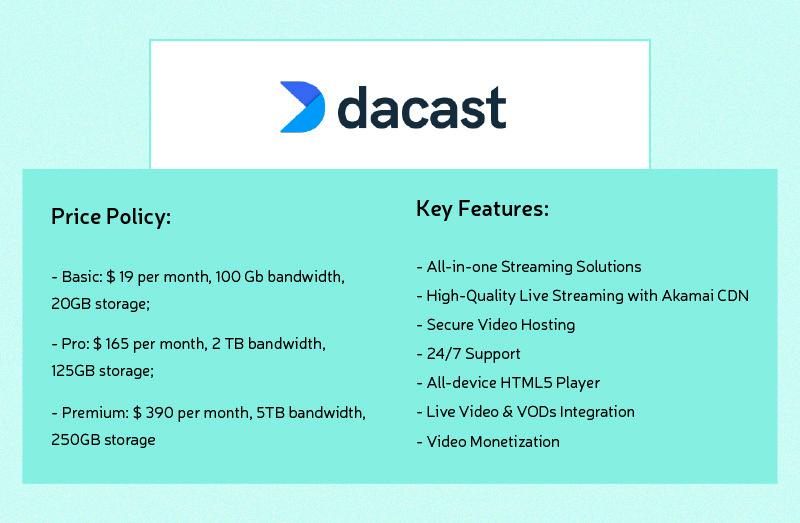
Still unimpressed? Then pay attention to the brands choosing DaCast: Canon, Nokia, eBay, Lenovo, etc.
IBM Cloud Video
IBM Cloud Video has gathered a loyal audience of grateful customers. And no wonder: the work of IBM Cloud Video is based on embedded cognitive technologies and Watson artificial intelligence functions. This has significantly expanded the possibilities of live streaming and delivering video on demand. Also, such an approach allows analyzing unstructured video materials more effectively. And developers, taking up the provided APIs and SDKs, can maximize the use of all the platform features to create their own applications.
Undoubtedly, IBM Cloud Video provides one of the best streaming APIs.
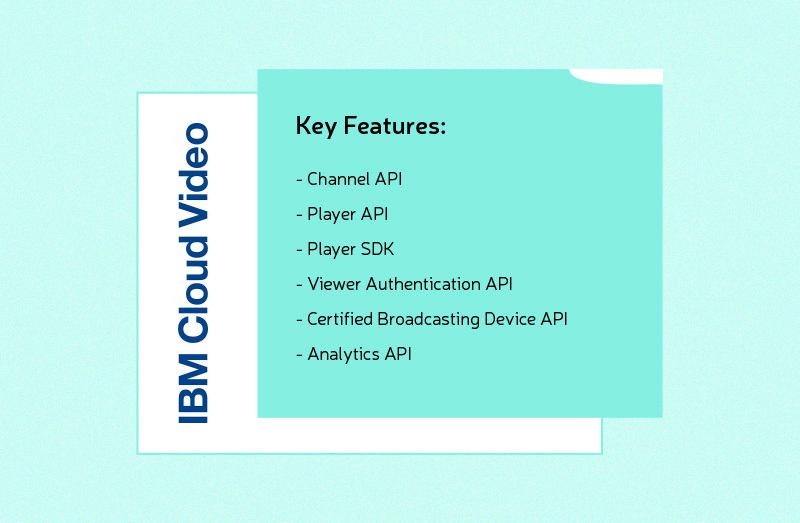
Cleeng
Cleeng is another versatile platform focused on authentication, commercialization, and protection of video content. The provider collaborates with Brightcove, which allows making full use of the capabilities of Video Cloud and Zencoder (we mentioned Video Cloud Media API and Zencoder when discussing Brightcove).
Cleeng offers several subscription plans:
-
Pay-as-you-go plan (the name speaks for itself);
-
Cleeng Enterprise License (more features, including analytics tools).

Contus
Contus was created with innovation in mind and remains to ride the crest of progress. Therefore, the provider may safely say that it offers a wide range of video broadcasting solutions to satisfy any business needs.
Contus is cloud-based and, most importantly, highly protected, which makes it especially appealing in the eyes of users. That's why its development tools are considered to be among the top streaming APIs.
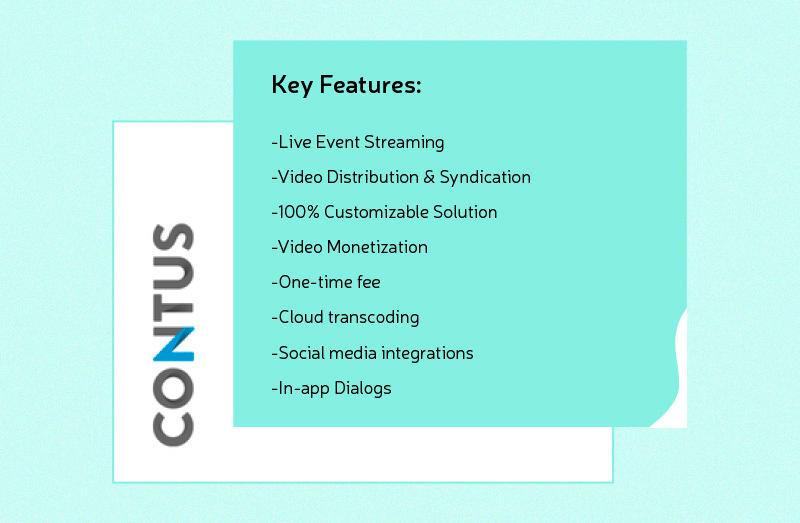
Ooyala
Ooyala is another illustrious wide-range video-service provider. Using its player APIs, a developer can make the player interface look like his resource and customize its functionality. And, of course, Ooyala offers tools to simplify the creation of streaming platforms.
By the way, in early 2019, Ooyala became part of Brightcove.
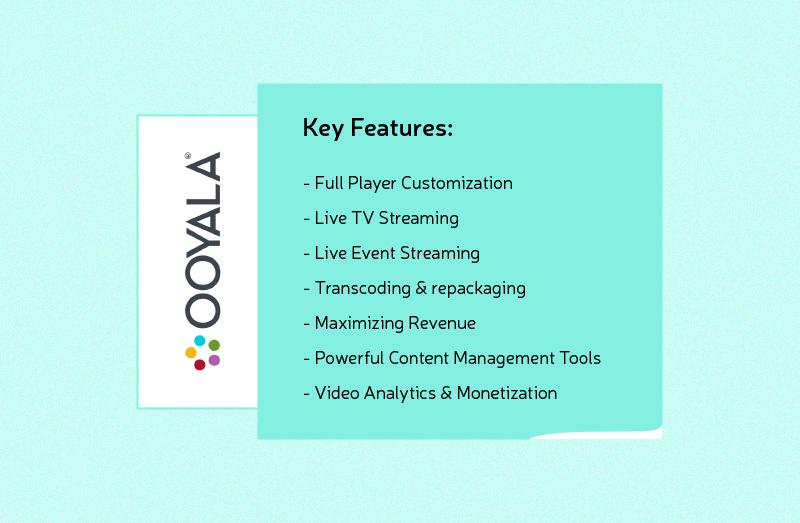
Twitch TV
10 million active users every day, and 2 million of them are streamers… Almost 26 thousand channels with active extensions... Yes, yes, we’re speaking about Twitch, a live video streaming platform targeted at online gamers. You can play online in real-time, watch other users play, chat with them, and much more.
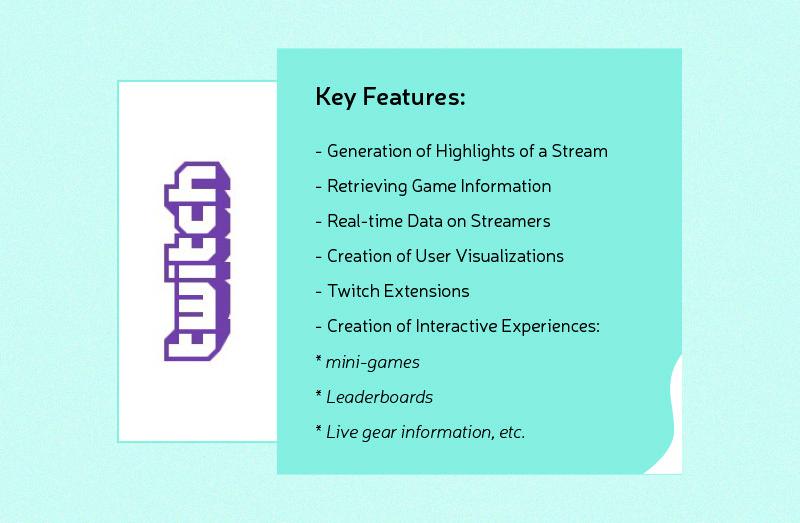
TweetTV video streaming APIs (REST API & Javascript SDK) give developers the ability to integrate with a resource by using its data, whether it’s channels, users or teams. The focus is on the relevance, accessibility, and intuitiveness of the information provided.
SoundCTL Audio Engine
Now it's time to talk about audio streaming APIs, and SoundCTL is the first on the list.
SoundCTL is a cloud-based real-time solution. Its API greatly simplifies the process of developing sites and mobile applications related to audio processing and streaming. SoundCTL Engine does the main work, and the client gets the opportunity to easily manage the audio content of his platform.
SoundCTL offers 3 price packages, and the costs of the cheapest and most expensive options are very different:
-
Basic. The simplest plan with a minimum of APIs features. $49
-
Pro, the most versatile service package. $79
-
Ultra, the highest level of access to SoundCTL Audio Engine capabilities. $499
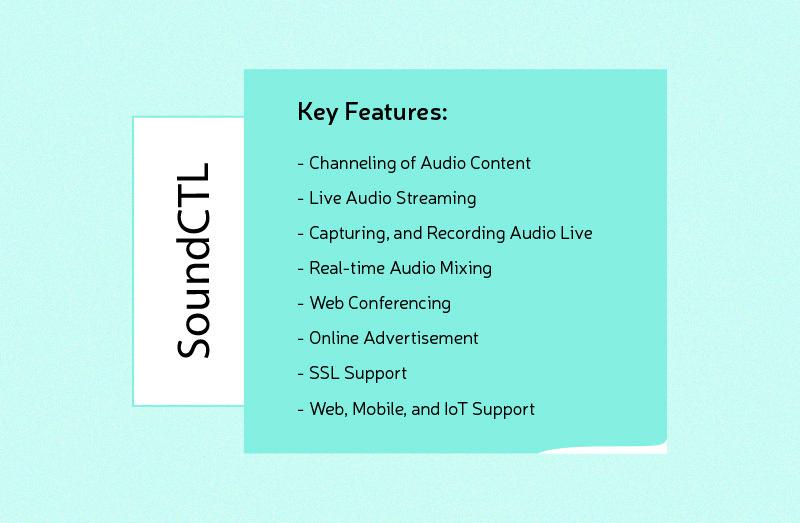
Deezer
Deezer is an audio streaming platform with a rich collection of musical compositions. The service is of French origin and has been operating since 2007.
Users can take advantage of Deezer both online and offline through mobile applications and websites.
Of course, DEEZER owners also took care of the developers, providing them with a convenient application programming interface for interacting with their system and its database in order to integrate audio content into their web and mobile platforms.

Playme
Another example of music streaming APIs is the Play.me API. With it, developers can embed widgets in their mobile applications and websites, thereby improving the experience of their users.
The Play.me platform boasts over 5 million tracks in its database, and the number keeps growing. So using a Play.me API is a far-sighted decision in order to better the resource with audio content.
Depending on your location, you may choose one of the options to interact with Play.me: without a commercial purpose, an affiliate program, partnership. Each one has its own access level.
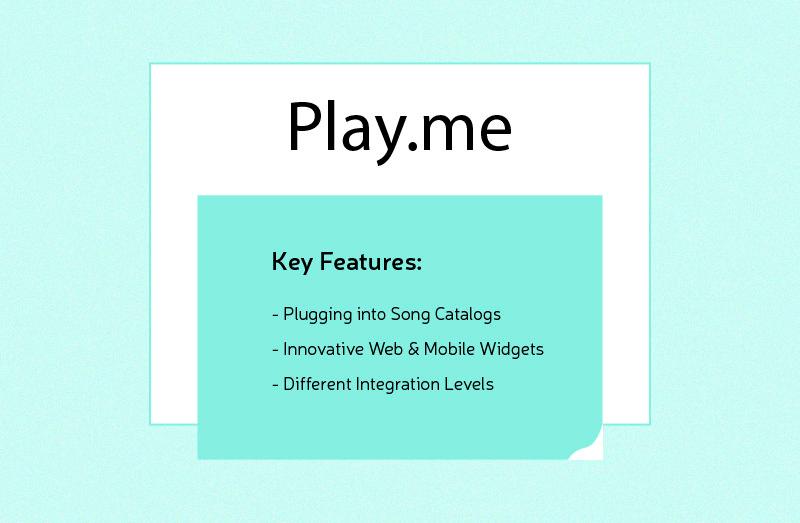
Spotify
We decided to complete our list of audio streaming APIs with Spotify. And it’s a good choice, for Spotify is one of the largest music streaming services in the world, which is used by almost 200 million people per month.
Developers would also benefit from using Spotify’s web and mobile APIs and SDKs. Thanks to these tools, developers gain access to the platform database and simplify their work, since Spotify takes care of everything related to authentication, playback, offline caching, and more.
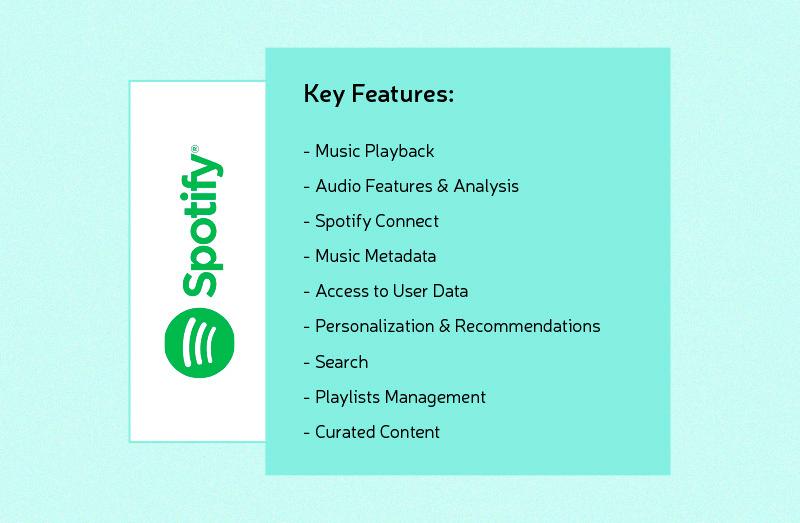
Tips for choosing a live video streaming API
How can you find the best API for video streaming?
We advise you to consider the following factors:
-
Location. Find out in which countries the video live streaming solutions in question would be available. Unfortunately, sometimes there may be a restriction of access by location.
-
APIs features. Above in the article, we gave a few examples of the key features offered by different solutions. As you could see, these lists are more or less similar, but not quite identical. Therefore, before choosing a video streaming API, make sure it's able to provide you with the necessary functionality.
-
Data formats. The format in which the API returns data also matters. It must fit into your system and should be convenient to work with.
-
Content protection (also known as Digital Rights Management or DRM). If your music or video content requires protection, you need to determine which provider uses the various technologies to make DRM possible.
-
Limits on requests. Speaking about the security of the site and application, it’s important to remember such a thing as DDOS attacks. Of course, live streaming API providers would like to avoid them. Hence the appearance of the limit on requests. And although you understand vendors' motives, these restrictions shouldn't affect your business. And if a certain provider has set a too small limit, try to find a better option.
-
Platform support. The service you choose should support the ability to work with all the platforms you need, directly or through the SDK.
-
Monetization features. Of course, ways to monetize video content should also be taken into account. The most popular models are PPV (pay-per-view) and subscription. In addition, there is an advertising model. If the provider offers such an option, check the method of advertising delivery. Server-side advertising insertion provides smoother operation and is less accessible to ad blockers.
-
Customizable video player. We've mentioned player APIs and video streaming APIs more than once in our article, and you probably noticed that many vendors provide the ability to change the interface design of their players. Thereby, you can brand the player as you wish so that it looks like other website sections (or app screens).
-
Detailed documentation. Perhaps the developer would be able to figure out how to use the API on his own, but it’s better when one can study the documentation with examples and explanations either.
-
Qualified technical support. And the last point, also very important, is the presence of a support team. When using an API, you may encounter problems in the solution of which you will need outside assistance.
Summary
Now you know how to choose the right live video streaming API, and it’s time to put knowledge into practice. You're likely to need professional help, and we're happy to provide it.



